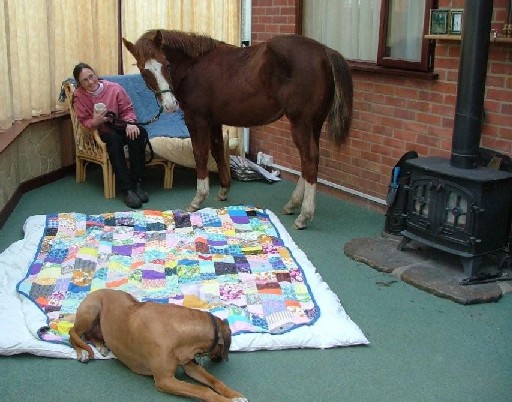
|
| The only problem here was persuading Chilli to go back out into the cold! |
Problem Horses or Horses with Behavioural Problems
Most horses with behavioural problems don’t have a solid foundation in place.
They have ‘holes’ in their training (the icing is melting) or are misunderstood by their owners.
Of course there are plenty of horses out there who are reacting in a negative
or even dangerous way due to being uncomfortable about something. This can be physical , mental or emotional.
How else can they tell us something is not right? We have to eliminate any source of discomfort – perhaps
a visit from vet, horse dentist , Saddle fitter, farrier, chiropractor or other practitioner such as a Bowen Therapist and
check amount/ type of feed, turnout and social time with others.
We then have to look at the owner. Is the owner right for the horse? Some horses have a high play drive
so won’t feel happy in a home that only takes them out for a weekend plod and can often become unmanageable when not
stimulated enough by activities they can channel their energy through.
Others are really good confidence givers to children or nervous adults because they have low spirit but would
probably find it a struggle to compete successfully in eventing. Most horses are good at something (just like us) but
matching them to the right partner can be tricky. If a person really wants to help change the horse’s behaviour,
then usually they have to look at themselves first. How much patience, time, commitment and money is the horse worth
to that owner?

|
| "of course there's always one that wants a discussion with you!" |
Some people have the determination and motivation to go to any length to improve the partnership with
their horse, whilst others want a quick fix so they can chase that blue rosette, sacrificing the horse’s confidence,
dignity and respect on the way. These horses begin to lose their ‘try’ and start to fall apart - ‘Enter
the problem horse’. Below is a list of some issues I work through:
- Won’t be caught
- Won’t lead or tie up
- Won’t load in a trailer or lorry
- Barges through your personal space when in field
or stable
- Kicks
- Bites
- Aggressive
at feed times
- Bucks
- Rears
- Bolts
- Ignores leg aids

- Picks up incorrect canter leads
- Won’t stop
- Hard to saddle or bridle
- Finds making a contact or working on the bit difficult
- Fidgets when being mounted
- Napping
- Refuses to jump
- Spooks
- Clipper shy
- Hard to handle his feet
- Headshy
- Scared of the vet
- Not happy or safe in company
of other horses
All the above issues are only symptoms. The real problem always stems from an imbalance of one or more
of 3 things:
- Confidence
- Respect
- Yielding to pressure